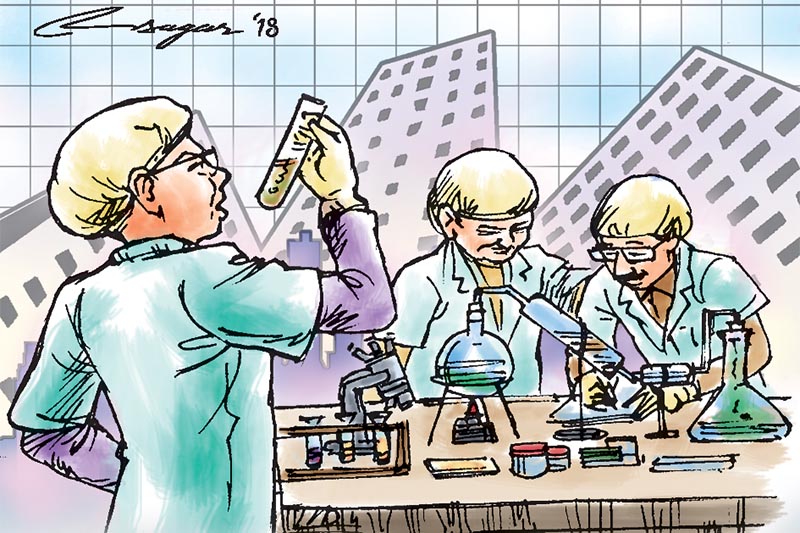Research centres: Time to restructure them
To follow evidence-based approach, research has to be put at the forefront. Inadequate investment has resulted in lesser number of publications and patents in the country, leading to less than desired progress in science and technology
Nepal has entered into a new era following recent political developments. The country has embraced the federal system discarding the unitary form of centralised governance. This restructuring is expected to bring about a total transformation in the country from poverty to prosperity. One of the positives of this restructuring is thus the emergence of prosperity as the national agenda, enjoying the support not only from the party in power but also in opposition. However, prosperity is easier said than done. It may be yet another hollow slogan unless an innovative approach is undertaken.
In its policies and programmes, the government has announced to follow an evidence-based approach.
But for the evidence-based style of functioning, research has to be put at the forefront instead of dumping it into a gloomy corner as we have been seeing at present. This is visible in the form of a minuscule 0.38 per cent investment made on research – in a stark contrast of our neighbouring China spending 2.5 per cent of GDP and India seeking to spike it to 1 per cent from the current spending of 0.8 per cent. Inadequate investment has resulted in lesser number of publications and patents in the country, leading to less than desired progress in science and technology.
Consequently, voices on the diminished functioning of the existing research institutes in the country are heard in the hallowed corridors of research edifices such as Nepal Academy of Science and Technology (NAST), Research Centre for Applied Science and Technology (RECAST) and Nepal Agricultural Research Centre (NARC) among others. Unfortunately, inadequate resources coupled with bureaucratic hurdles that plague such research centres are seldom taken into account while making enthusiastic comments. Moreover, several achievements made by them in the midst of what could be called unfavourable political situation prevailing in the country have remained in the shadow.
Let’s look at some examples.
Russian Academy of Sciences (RAS) was criticised for its lack of activity. As a result, the Federal Agency for Scientific Organisation (FASO) was created to coordinate with the scientific centres. What followed, however, was a war of words between RAS and FASO. The former accused the later of increasing bureaucratic pressure on research institutions and the lack of transparency. FASO, in turn, responded by alleging RAS that it was taking a passive stance and delaying the proposal for its restructuring.
FASO quickly suggested a four-tiered structure consisting of the Federal Research Centers (FRC), National Research Institutes (NRI), Federal Scientific Centers (FSC) and Regional Scientific Centers (RSC). Whilst the FRC had been mandated to achieve valid results in accordance with the established priority of the government, NRI had been told to focus on fundamental research. FDC, in turn, was expected to develop and assist in the modernisation of production technologies and the RSC in the comprehensive development of territories and regions through the merger of similar institutions. This proposal, however, had to face a lot of opposition. In the end, FASO was virtually liquidated and relegated to a small corner under the ministry.
The Chinese Academy of Science had also come under intense pressure for what was described as “its inability to produce visible results. Following the suggestions of Chinese President Xi Jinping, it underwent some restructuring by establishing four centres. These were: firstly, the Centers of Excellence created to focus on basic science; secondly, Innovation Academies to concentrate on underdeveloped commercial potential; thirdly Centres of Big Science towards promoting domestic and international collaboration; and fourthly, Institutes with Special Characteristics to foster local development and sustainability. The aforementioned Russian and Chinese restructuring processes have glaringly focussed on four areas and they are the priority of the nation – fundamental research, modernisation of production technologies and development of industry in the territories and regions.
The concept paper of the 14th Five Year National Plan prepared by the National Planning Commission has envisioned the creation of Umbrella Research Organisation for the integration of research centres existing in the country, laying emphasis on the need of restructuring of research centres.
The existing research centres could be loosely assembled around NAST as an umbrella agency, addressing the national priorities. RECAST could devote itself to fundamental research because of it being under the university. Moreover, NARC could engage itself in materialising the development aspirations of the provinces due to their agrarian nature. Other research centres including those operating in the private sector could be developed as innovation research centres.
Restructuring is about the reorganisation of the existing state. It is characterised by mergers and acquisitions. These activities should be carried out by ensuring that no inconvenience is caused to any of the merged or the acquired entities. It is thus necessary to make a deep study involving the best of the brains of the concerned sector to arrive at a proper restructuring plan of action. An undue haste may lead to what is known as hurry makes a bad curry.






